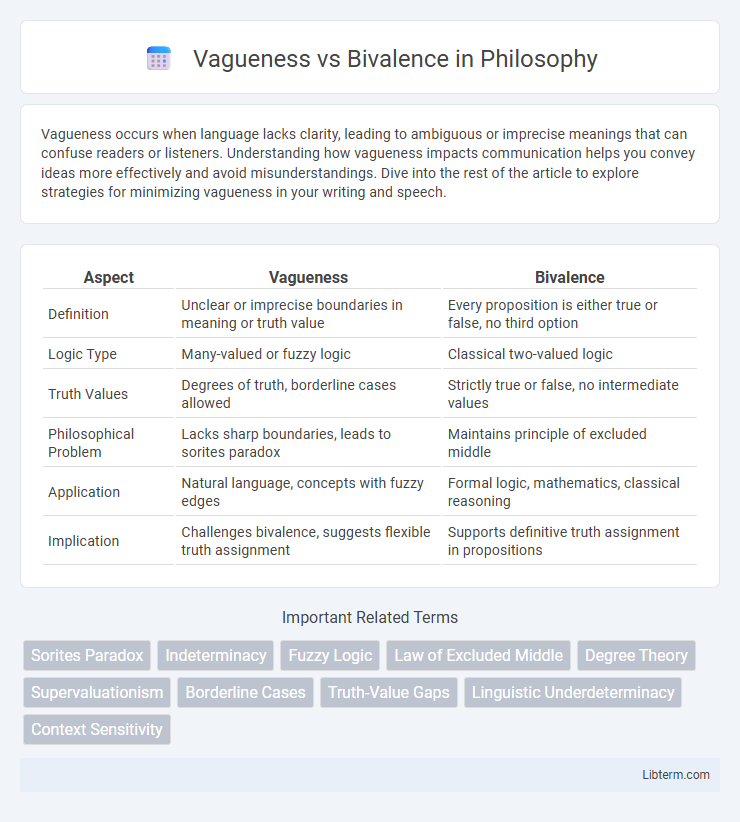Vagueness occurs when language lacks clarity, leading to ambiguous or imprecise meanings that can confuse readers or listeners. Understanding how vagueness impacts communication helps you convey ideas more effectively and avoid misunderstandings. Dive into the rest of the article to explore strategies for minimizing vagueness in your writing and speech.
Table of Comparison
| Aspect | Vagueness | Bivalence |
|---|---|---|
| Definition | Unclear or imprecise boundaries in meaning or truth value | Every proposition is either true or false, no third option |
| Logic Type | Many-valued or fuzzy logic | Classical two-valued logic |
| Truth Values | Degrees of truth, borderline cases allowed | Strictly true or false, no intermediate values |
| Philosophical Problem | Lacks sharp boundaries, leads to sorites paradox | Maintains principle of excluded middle |
| Application | Natural language, concepts with fuzzy edges | Formal logic, mathematics, classical reasoning |
| Implication | Challenges bivalence, suggests flexible truth assignment | Supports definitive truth assignment in propositions |
Understanding Vagueness: A Semantic Overview
Vagueness arises when linguistic expressions lack precise boundaries, leading to borderline cases where truth values are indeterminate, contrasting with bivalence which holds every proposition as either true or false. Understanding vagueness involves analyzing concepts such as fuzzy boundaries, sorites paradoxes, and truth-value gaps that challenge classical logic's strict dichotomies. Semantic frameworks like supervaluationism and fuzzy logic offer models to capture the gradations and indeterminacy inherent in vague language, providing a nuanced approach beyond strict bivalence.
Defining Bivalence: The Principle Explained
The principle of bivalence asserts that every declarative statement must be either true or false, with no intermediate truth values allowed. This classical logic foundation contrasts with vagueness, where some statements lack precise truth assignment due to indeterminate boundaries. Bivalence underpins binary truth evaluations essential for formal logical systems and precise semantic analysis.
Historical Perspectives on Vagueness and Bivalence
The historical debate on vagueness versus bivalence traces back to classical logic's strict adherence to the principle of bivalence, where every proposition is either true or false. Philosophers like Aristotle laid foundational work endorsing bivalence, while later thinkers such as Ludwig Wittgenstein and Charles Sanders Peirce highlighted the challenges vagueness poses to this dichotomy. Developments in fuzzy logic and supervaluationism emerged as responses to these challenges, attempting to reconcile everyday language's inherent vagueness with the rigid structure of bivalent logic.
Key Differences Between Vagueness and Bivalence
Vagueness refers to the lack of precise boundaries in concepts or terms, causing uncertainty in classification, while bivalence is the logical principle that every proposition must be either true or false. Vagueness challenges the law of bivalence by introducing borderline cases where truth values are indeterminate or undefined. The key difference lies in vagueness affecting semantic clarity, whereas bivalence governs the binary truth value assignment in classical logic.
The Role of Language in Vagueness
Language inherently shapes vagueness by allowing terms with borderline cases and indeterminate boundaries, which challenges the principle of bivalence where statements are strictly true or false. This semantic flexibility facilitates communication but introduces ambiguity, as expressions like "tall" or "heap" lack precise cutoffs. The role of language in vagueness underscores the dynamic interplay between linguistic context and logical evaluation, revealing limitations in classical binary logic.
Bivalence in Classical Logic
Bivalence in classical logic asserts that every proposition must be either true or false, with no middle ground or alternative truth values accepted. This principle underpins the law of excluded middle, ensuring clear, unambiguous evaluation of logical statements within classical systems. Vagueness challenges bivalence by introducing borderline cases where truth values become indeterminate, but classical logic maintains strict adherence to binary truth assignments for deductive rigor.
Philosophical Debates: Vagueness vs Bivalence
The philosophical debate on vagueness versus bivalence centers on whether every proposition must be either true or false, known as the principle of bivalence, or if some propositions are inherently vague and lack clear truth values. Vagueness challenges classical logic by presenting borderline cases, where predicates like "tall" or "heap" resist precise categorization, undermining strict true/false dichotomies. This debate influences theories of semantics, with proponents of vagueness advocating for many-valued or fuzzy logic systems, while defenders of bivalence uphold classical logic's binary truth assignments.
Real-World Examples of Vagueness
Vagueness arises in real-world contexts such as legal language, where terms like "reasonable doubt" lack precise boundaries, leading to interpretation challenges. Another example is everyday descriptors like "tall" or "heap," which have borderline cases that resist clear true-or-false classification, illustrating the failure of bivalence. These instances highlight how natural language often deviates from strict bivalent logic, necessitating more nuanced frameworks like fuzzy logic or supervaluationism.
Semantic Theories Addressing Vagueness and Bivalence
Semantic theories addressing vagueness challenge the classical principle of bivalence, which asserts that every proposition is either true or false. Many-valued logics introduce intermediate truth values to capture borderline cases where vagueness arises, while supervaluationism maintains classical logic by considering all "precisifications" that make vague terms precise. These approaches aim to reconcile the intuitive indeterminacy of vague expressions with rigorous semantic frameworks.
Implications for Logic and Communication
Vagueness challenges classical logic's bivalence principle by introducing truth-value indeterminacy where statements cannot be classified strictly as true or false, leading to the development of many-valued and fuzzy logic systems. This departure from bivalence impacts communication by creating ambiguities and interpretative flexibility, which can hinder precise information exchange but also allows for nuanced expression and contextual understanding. The interplay between vagueness and bivalence drives advancements in formal semantics, pragmatics, and artificial intelligence, aiming to model and manage uncertainty in both human and machine reasoning.
Vagueness Infographic

 libterm.com
libterm.com